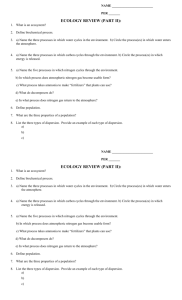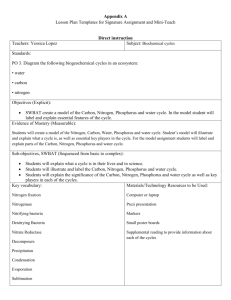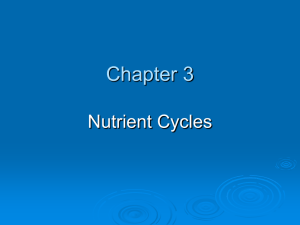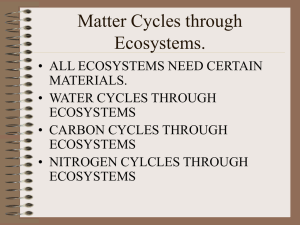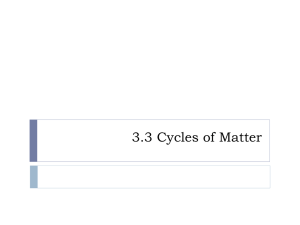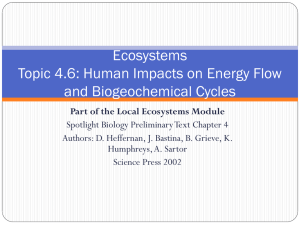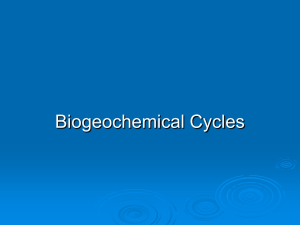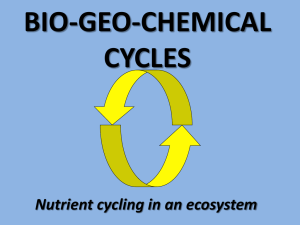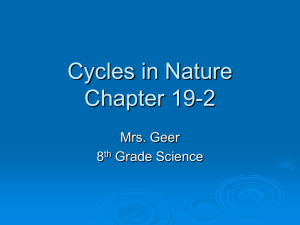The Four Spheres and their CYCLES
advertisement
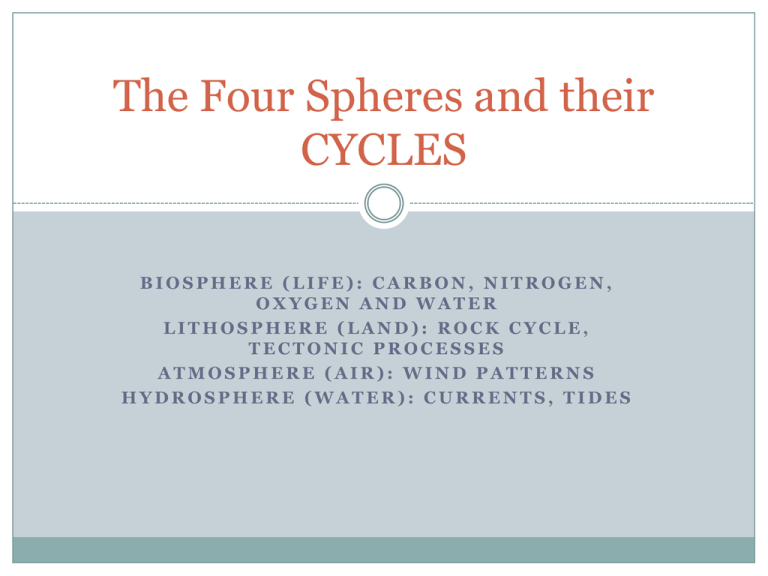
The Four Spheres and their CYCLES BIOSPHERE (LIFE): CARBON, NITROGEN, OXYGEN AND WATER LITHOSPHERE (LAND): ROCK CYCLE, TECTONIC PROCESSES ATMOSPHERE (AIR): WIND PATTERNS HYDROSPHERE (WATER): CURRENTS, TIDES CYCLES IN THE BIOSPHERE Nutrient Cycles support life (biosphere) Carbon, oxygen, nitrogen and water make up 99 % of living matter. Human activity AND natural activity can alter these cycles. CARBON CYCLE Watch the NASA video on the carbon cycle. (you may also refer to the textbook, pages 49-50) Assignment: 1. Identify natural places where carbon exists. 2. Identify the processes that move carbon from one of these places or stores to another. 3. List ways that humans can alter the carbon cycle. 4. What are the results of these changes? NITROGEN CYCLE Nitrogen by itself is not that useful. We count on bacteria that live on plant roots to convert it to ammonia (NH4) and nitrates (NO2), which ARE useful. The plants that have these bacteria are called LEGUMES. (alfalfa, peas, beans, clover) Nitrogen interactive Nitrogen animation Read page 50-51 and answer the following questions. 1. What are the states in the nitrogen cycle? 2. What are the processes? 3. Why do farmers plant alfalfa and clover? 4. How would spreading lots of manure affect the nitrogen cycle? 5. How does burning fossil fuels affect the nitrogen cycle? 1. http://news.mongabay.com/2009/0604-hance_nitrogen.html OXYGEN CYCLE Connected very closely to the other cycles (CO2) (NO2) (H20) O2 is produced by plants during photosynthesis. From the atmosphere, it reacts with burning to form carbon dioxide. Animals breathe it in and breathe out carbon dioxide. Carbon dioxide and water help dissolve soil nutrients and are absorbed by plants. WATER CYCLE pg. 52-53 Necessary for other nutrient cycles. Draw your own water cycle. Identify short term storage and long term storage areas for water. Be sure you can define the processes. 2. PARTICULARLY note the term AQUIFER. 3. List ways humans can interfere with the water cycle. 1. CYCLES IN THE LITHOSPHERE ROCK CYCLE and Plate Tectonics (page 55 in text) Identify the three types of rock and the way that each is formed. 2. Identify the main ideas of plate tectonics. 1. a. b. c. What is it? Who is responsible for the idea? How does it affect the earth? CYCLES in the ATMOSPHERE: wind patterns Wind is caused by unequal heating of the earth’s atmosphere. Warm air is light and it rises (low pressure) Cold air is dense and it sinks (high pressure) Wind moves from areas of high pressure to areas of low pressure. The direction of wind is determined by the things that influence which areas are warm and which are cold Large bodies of water or land Amount of energy from the sun And the spinning of the earth This creates a pattern of winds that can be identified. Using the map provided and either the atlas or the maps on page 62 of the text, identify the wind direction in the following places in both July and January. What influence will these winds have? Nova Scotia UK Namibia West coast of India Northern Australia ONE AFFECT OF PREVAILING WINDS: The Monsoon Season http://education.nationalgeographic.com/encyclope dia/monsoon/?ar_a=1 http://photos.denverpost.com/2011/09/26/photosdeadly-flooding-in-india/ http://www.boston.com/news/world/asia/articles/2 011/09/27/monsoon_rains_floods_kill_scores_in_ north_east_india/ http://wiki.answers.com/Q/Why_are_monsoons_i mportant_to_people_in_Southeast_Asia CYCLES IN THE HYDROSPHERE Currents. Currents affects air temperature. Currents affect nutrient cycles. What currents affect Nova Scotia? Newfoundland? Western South America? (Peru) Map Maker Interactive CYCLES IN THE HYDROSPHERE: TIDES Pg. 66-67 What causes tides? How do tides affect people? How can people use tides?
